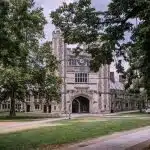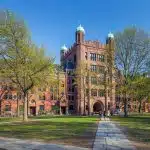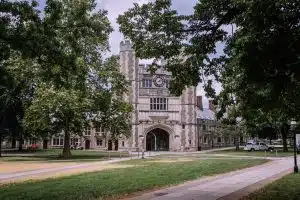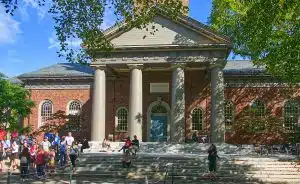So, you’re thinking about applying to some of the hardest public colleges to get into? Well, buckle up because you’re in for a wild ride. The competition is fierce, the expectations are sky-high, and the application process can feel like a sprint to the finish line. But if you’ve got the ambition, the grit, and the grades to back it up, these top public universities could be your ticket to an incredible education and career.
Let’s explore the hardest public colleges to get into and break down exactly what makes them so competitive and what it takes to earn a spot. From UCLA to the University of Virginia, we’ll explore the schools that consistently reject thousands of applicants—and the secrets to standing out in the crowd.
- What Are the Top Hardest Public Colleges to Get Into?
- How to Get into the Hardest Public Colleges
- Frequently Asked Questions
- Takeaways
What Are the Top Hardest Public Colleges to Get Into?
Let’s jump straight into some of the hardest public colleges to get into. These schools stand out due to their low acceptance rates, academic rigor, and global prestige. If you’re targeting one of these, be prepared for a highly competitive admissions process.
1. University of California, Los Angeles (UCLA)
If you’re aiming for the top, the University of California, Los Angeles (UCLA) is the place to be. As the #1 public university according to U.S. News & World Report, it’s no surprise that UCLA is also the hardest public university to get into. The acceptance rate? Just 9%. With over 100,000 applications each year, it’s one of the most competitive schools in the country.
In fact, UCLA is the most applied-to university in the entire country. For Fall 2024, the school got a whopping 173,651 applications—with 146,276 from high school seniors and 27,375 from students looking to transfer. Out of all those hopefuls, 13,114 were accepted, but only 6,610 actually enrolled. That’s a pretty big gap, showing just how selective UCLA really is. The competition for those spots is fierce, and getting in is no easy feat.
UCLA’s academic reputation is off the charts. It’s known for world-class programs in film, business, engineering, and the sciences, so you can imagine how high the stakes are. On top of top-tier SAT scores (1405 on average) and ACT scores (31 on average), UCLA is looking for applicants who stand out beyond the numbers.
Leadership, community involvement, and a strong personal story are all part of the equation. If you want in, you’ve got to show that you can contribute to the UCLA community in a big way.
And if you’re wondering about GPA, the average GPA of admitted students is around 3.93, which is incredibly competitive, further cementing UCLA’s position among the hardest public colleges to get into.
2. University of California, Berkeley (UC Berkeley)
Right behind UCLA, we’ve got UC Berkeley, which U.S. News & World Report consistently ranks at #2 for best public schools. With an acceptance rate of 11%, UC Berkeley is another one of the hardest public colleges to get into. Berkeley is a powerhouse in areas like engineering, business, and political science, and it has a reputation for being an academic leader.
Every year, the university receives thousands of applications from incredibly talented students around the world, all hoping to join the ranks of its prestigious student body. 124,243 people applied to UC Berkeley for the class of 2028, which is another reason why it’s one of the hardest public colleges to get into in the country.
The admissions process at Berkeley is intense. While you’ll need solid test scores (1405 SAT and 31 ACT on average), the university places a huge emphasis on what you’ve done outside the classroom. They want to see applicants who are not only academically outstanding but also show initiative, leadership, and a passion for what they do.
If you want to stand out, make sure your application highlights your extracurricular activities and any meaningful projects or leadership roles you’ve taken on. As for GPA, the average admitted student has a GPA of around 3.9, which reflects the level of academic excellence UC Berkeley expects from its applicants.
UC Berkeley does have specific GPA requirements for admission. For California residents, a minimum GPA of 3.0 is mandatory, and for non-residents, the requirement is 3.4.
3. University of Michigan, Ann Arbor (UM-Ann Arbor)
University of Michigan, or UM-Ann Arbor, is another tough school to get into, consistently landing in the top 10 public universities in the country. Ranked #3 in the U.S. News Best Public Schools for 2024, UM-Ann Arbor has a reputation for excellence in fields like engineering, business, and social sciences.
UM-Ann Arbor hasn’t released the statistics for the class of 2028 yet, but 87,632 people applied for the Class of 2027. With an acceptance rate of around 18%, only 15,722 applicants were offered admission, and only 7,466 of those enrolled. This further reinforces its status as one of the hardest public colleges to get into.
So, what does it take to get into UM-Ann Arbor? First, you’ll need strong academic credentials. UM-Ann Arbor is test-optional, but SAT scores typically fall between 1350 and 1530, and ACT scores range from 31 to 34. The average GPA for admitted students is 3.9, which shows the competitive nature of admissions.
But academics aren’t the only thing U-M looks for. The admissions committee places a heavy emphasis on extracurriculars, leadership, and community involvement. UM-Ann Arbor wants students who not only excel in the classroom but also have the drive and passion to make an impact on campus.
If you’re applying, make sure your application shows that you’re more than just a test score—you need to be someone who can contribute to the dynamic, collaborative atmosphere that defines UM-Ann Arbor.
4. University of Virginia (UVA)
The University of Virginia isn’t just known for being beautiful—it’s also one of the hardest public colleges to get into. Ranked #4 in the U.S. News Best Public Schools list, UVA is a powerhouse in areas like law, business, and the humanities.
With an acceptance rate of 16.4%, it’s still highly selective, but not quite as competitive as UCLA or Berkeley. Still, UVA receives tens of thousands of applications every year, all vying for a spot at this top-tier institution.
For the Class of 2028, just shy of 59,000 students threw their hats in the ring for UVA, which is a 4% jump from last year and a 17% increase from 2022. UVA ended up offering spots to 9,665 of those applicants, which shows just how tough it is to make the cut at one of the hardest public colleges to get into.
UVA looks for more than just good grades (though you’ll need to have them). While UVA is test-optional, strong SAT (1445 on average) and ACT (33 on average) scores are also important. But more than that, UVA also wants students who are well-rounded and have proven themselves in leadership roles.
Whether it’s through extracurricular activities, community service, or unique personal experiences, UVA is interested in students who will contribute to its vibrant campus life. The university has a long tradition of producing graduates who go on to make a difference in public service, so showing a passion for community involvement could give you an edge.
The average GPA of admitted students is around 4.3, which shows that UVA is looking for top-notch students who excel both inside and outside the classroom.
5. University of North Carolina at Chapel Hill (UNC)
Last but certainly not least, we have the University of North Carolina at Chapel Hill (UNC). Ranked #5 among best public schools, UNC is another of the hardest public colleges to get into, with an acceptance rate of around 19%. Out of 73,192 total applicants, the class of 2028 welcomed 5,624 students.
Known for its strong programs in public health, business, and law, UNC has a well-earned reputation for academic excellence, and its beautiful campus and vibrant campus life doesn’t hurt either.
Getting into UNC requires more than just good grades. While strong SAT (1390-1520) and ACT (29-34) test scores are important, UNC is test-optional and the admissions process is holistic. UNC wants to know what you’ve done outside the classroom. Leadership roles, volunteer work, and community involvement are all key factors in the decision-making process at one of the hardest public colleges to get into.
UNC values applicants who show initiative and who will contribute to the university’s collaborative, community-oriented environment. If you’re passionate about public service or making an impact, UNC might be the perfect fit.
The average GPA for admitted students is around 4.0, which shows that UNC, like many of the hardest public colleges to get into, looks for high-achieving students who stand out in multiple areas.
How to Get into the Hardest Public Colleges
So, now that you know what makes the hardest public colleges so selective, how can you actually increase your chances of getting in? The good news is that while these schools are highly competitive, there are things you can do to stand out from the pack.
1. Maintain a strong academic record.
Let’s start with the basics: grades and test scores. It may seem obvious, but your GPA and test scores are still the most important factors in college admissions. And to stand out at top schools like UCLA or UVA, you’re going to need to aim for nothing less than stellar.
For your GPA, you should aim for a 4.0 or as close to it as possible. But keep in mind, it’s not just about getting all As. Public colleges are looking for students who are willing to challenge themselves.
So, it’s crucial to take on AP, IB, or honors courses that demonstrate your ability to handle rigorous material. For example, UCLA expects applicants to come in with a highly competitive GPA—think in the range of 4.0 or above, especially for students applying from outside of California.
While more schools are dropping SAT/ACT requirements, many of the hardest public colleges to get into still consider them, especially when they’re optional. So, if you’re submitting scores, aim for 1400+ on the SAT or 30+ on the ACT.
If you’re aiming for UC Berkeley or the University of Michigan, you’re going to need scores in the top 25% of applicants to even be considered competitive. This means you’ll want to focus on prepping for these tests—whether that’s through formal classes, private tutors, or independent study.
Some schools, like UC schools (including UCLA and UC Berkeley), have become test-optional, but strong scores can still help you stand out in a sea of other top-performing applicants. So, if you’ve got the ability to score well, don’t hold back.
2. Get involved outside of the classroom.
Top colleges are looking for students who are well-rounded. Sure, a solid academic record is crucial, but colleges want to know who you are outside the classroom too. So, make sure you’ve got a strong record of extracurricular activities.
From sports and volunteer work to being involved in clubs, schools want to see that you’re passionate about something beyond your GPA. It’s not just about being involved in a ton of activities—it’s about showing dedication and leadership.
For example, getting involved in leadership roles (like being the captain of a sports team or president of a club) shows that you can handle responsibility and that you’re willing to take initiative.
If you’re an athlete, make sure you highlight your commitment and skills. Being a team captain or competing at a high level (like being part of a state championship team) shows that you’re not only dedicated but also capable of working with others to achieve a goal.
Similarly, if you’ve been involved in community service or other leadership activities, be sure to highlight how you made a difference. Colleges love students who contribute to their communities.
It’s not about being involved in every single club or organization under the sun. Colleges prefer students who show deep commitment to a smaller number of activities. If you’ve spent 4 years working at a local shelter or have been an editor of your school newspaper, make that your focus. Show how these experiences have shaped you and prepared you for college life.
3. Write a memorable personal statement.
When it comes to highly competitive schools, your personal statement (or application essay) is your chance to really shine. This is where you can tell your story, express your passions, and explain why you’re a great fit for the school. A strong essay can tip the scales in your favor, especially if the rest of your application is solid.
Admissions officers read thousands of essays, so you need yours to stand out. The best essays are authentic, reflective, and personal. Don’t just write what you think they want to hear—tell your true story. What makes you tick? What experiences have shaped who you are today? Think about the challenges you’ve faced, the lessons you’ve learned, and how that has prepared you for college life.
Be specific. A vague essay won’t do you any favors. Instead of just saying you’re passionate about helping others, give examples of how you’ve helped others. Have you organized a charity event? Volunteered at a local food bank? Or maybe you’ve mentored a younger student or started a community project? Be specific and show how these experiences have made you who you are and prepared you for life at a challenging college.
One of the most important parts of your essay is showing why you’re applying to that specific school. What about their culture, values, or programs resonates with you? Why do you want to attend that particular school? Admissions officers want to know you’ve done your homework and that you’re truly passionate about becoming a part of their community.
If you can tie in the school’s offerings to your personal goals and experiences, you’ll make a much stronger case for yourself.
4. Get strong letters of recommendation.
While your personal statement is a chance to tell your story, letters of recommendation are the part of the application where someone else sings your praises. A well-written letter from a teacher, coach, or mentor can make a huge difference. Make sure you choose recommenders who know you well and can speak to your strengths and character.
Ideally, you want a teacher who knows you well enough to write a detailed and thoughtful letter. Choose someone who can speak not just to your academic ability but also to your character, your work ethic, and your potential.
If you’ve been involved in extracurricular activities, consider asking someone who has seen you in a leadership or team-oriented role. For example, if you’ve been actively involved in a volunteer organization, ask that project leader to write you a letter of recommendation.
Don’t be afraid to ask for a draft. Many teachers and mentors are happy to help you draft your letter or at least give you a sense of what they’ll include. Don’t be scared to offer them some insight into what you’d like them to highlight. The more specific and detailed your letter of recommendation is, the better.
Getting into the hardest public colleges may seem tough, but with the right strategy, it’s definitely possible. Focus on maintaining strong grades, getting involved in extracurriculars, and writing a standout essay. A little hard work goes a long way in boosting your chances, so stay focused and give it your best shot. You got this!
Frequently Asked Questions
1. How do the hardest public colleges to get into select students?
The hardest public colleges to get into typically use a holistic admissions process, looking at more than just your GPA and test scores. They consider extracurricular activities, essays, letters of recommendation, and sometimes even interviews. The goal is to admit well-rounded students who will thrive both academically and socially on campus.
2. How competitive are the hardest public universities to get into?
The hardest public universities to get into are incredibly competitive. With acceptance rates often falling below 20%, the competition is fierce. For instance, UCLA, the most applied-to public university in the U.S., received a staggering 173,651 applications for Fall 2024, and only 13,114 students were accepted—making its acceptance rate just 9%. This level of competition makes getting into these schools not just tough, but incredibly selective, as you’re up against thousands of other high-achieving applicants.
3. What can I do to improve my chances of getting into the hardest public colleges?
To increase your chances of getting into the hardest public colleges, focus on maintaining a high GPA, achieving strong test scores, and getting involved in extracurriculars that show leadership and dedication. Writing a compelling personal statement that highlights your unique qualities can also make a big difference.
4. What’s the average GPA for students who get into the hardest public colleges?
The hardest public universities to get into typically expect applicants to have a GPA of at least 3.8, often higher. Many of these schools also look for applicants who have taken advanced coursework like AP or IB classes, which shows they can handle the academic rigor these institutions demand.
Takeaways
When applying to some of the hardest public colleges to get into, keep these tips in mind to boost your chances:
- Strong academic performance is a must. Top public universities look for applicants with competitive GPAs (3.8, preferably higher) and test scores (1400+ SAT, 30+ ACT). It’s also important to challenge yourself by taking AP, IB, or honors courses to show your academic rigor.
- Extracurriculars matter just as much as grades. Colleges want to see that you’re well-rounded. Leadership roles, volunteer work, and involvement in meaningful activities show initiative and dedication. Stand out by showing commitment and impact in fewer, but more significant, activities.
- Your personal statement should be unforgettable. Use your essay to tell your unique story—be specific, reflective, and show how your experiences align with the university’s culture and values. A strong, personal essay can be the deciding factor in a competitive application.
- Letters of recommendation should highlight your strengths. Choose recommenders who know you well and can speak to your character, work ethic, and academic abilities. A thoughtful letter can make a big difference in your application.
- Getting into top public colleges can feel nearly impossible with low acceptance rates and thousands of applicants competing for a spot. But don’t worry—a college admissions consultant can help. From optimizing your GPA and test scores to writing a compelling personal statement, AdmissionSight can guide you through every step.



















































